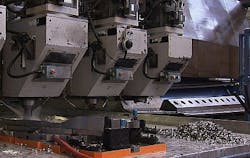Airbus announces metal cutting for first production A320neo jetliner on first day of Farnborough
FARNBOROUGH, England, 9 July 2012. On the first day of the Farnborough International Airshow 2012, Airbus officials announced they have performed the first metal cutting in preparation for building the first fuel-efficient Airbus A320neo passenger jetliner in Toulouse, France.
Marking the start of manufacturing of the airliner, machining began of the first engine pylon component at the “Saint-Eloi” Airbus dedicated pylon and nacelle factory, Airbus officials say. The A320neo is to enter service in the middle of this decade.
The Airbus A320neo -- short for new engine option -- stole the show last year at the Paris Air Show when Airbus announced sales of nearly 700 of the fuel-efficient A320neo, and Airbus officials declared the A320neo to be the star of the show. Airbus says the A320neo is the world's fastest-selling passenger jetliner.
Of the recent first metal cutting, pylons are structures that hold the engine to the wing. The new pylon for the A320neo is common with the existing A320’s pylon design, while also using more titanium and advanced architectures developed for the A380 pylon. In addition, the new component also features an advanced aft-pylon-fairing tailored for the fuel-efficient A320neo engines, company officials say.
The A320neo will enter service in late 2015. It incorporates latest generation engines and large Sharklet wingtips devices that together with the new engines will deliver up to 15 percent in fuel savings, company officials say. The aircraft has more than 1,400 firm orders since its launch in 2010.
The twin-engine Airbus A320neo family consists of the latest-model A320, A321, and A319. All the new aircraft have sharklet wing tips and offer a choice of the CFM International LEAP-X or the Pratt & Whitney PW1100G PurePower engines.
The aerodynamic and engine improvements in the A320neo give the aircraft family a 15 per cent reduction in fuel consumption compared with earlier versions, as well as two tonnes of additional payload, as much as 500 nautical miles of more range, lower operating costs, and reductions in engine noise and emissions, company officials say.
Sharklets on the aircraft wingtips can add more than 3.5 percent savings in overall fuel consumption on long routes, while also improving takeoff performance and increasing payload by 1,100 pounds for additional range or more passengers.
The A320neo can seat as many as 150 passengers in a two-class arrangement, and as many as 180 passengers with high-density seating. The stretched-fuselage A321neo can seat as many as 185 passengers in a two-class layout, or as many as 220 passengers in a high-density cabin. The shorter-fuselage A319neo can seat 124 passengers in two classes or as many as 156 passengers in a high-density cabin setup.
For more information contact Airbus online at www.airbus.com, or the Farnborough International Airshow at www.farnborough.com. Also follow Military & Aerospace Electronics and Avionics Intelligence daily Farnborough show coverage online at www.militaryaerospace.com/farnborough-report.
Follow Military & Aerospace Electronics and Avionics Intelligence news updates on Twitter
